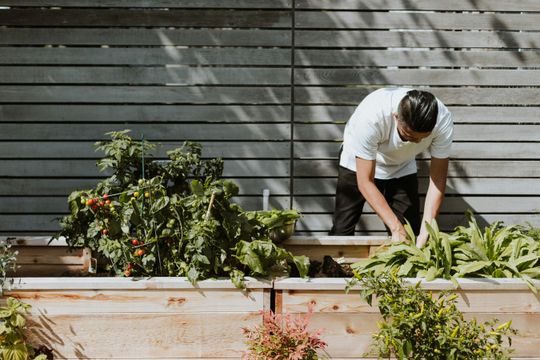In today’s world, sustainability and eco-consciousness are at the forefront of many homeowners’ minds. One way to contribute to the planet's well-being is by creating an eco-friendly garden. Not only does this promote a healthier environment, but it also reduces water usage, fosters biodiversity, and encourages sustainable living. Whether you have a sprawling backyard or a small urban plot, there are simple steps you can take to transform your garden into a more sustainable and eco-conscious space.
Water-Wise Gardening
Water conservation is a key aspect of eco-friendly gardening, especially in regions prone to drought or high temperatures. One effective way to reduce water waste is by using wicking beds. These self-watering garden beds are designed with a water reservoir at the base, providing a steady source of moisture to plants as needed. According to Karlie Ross from Limitless Queensland, “Wicking beds are the best for eco-friendly garden beds. These are self-watering structures that have a water reservoir at the base.” By using this method, you not only save water but also ensure your plants stay hydrated without constant watering.
For those who enjoy having garden features like fountains, sustainable water management is also important. While fountains typically recycle their own water, evaporation can lead to water loss over time. Phillip Hendriks from Pots n Pots recommends using rainwater for replenishment: “Buy a water tank to store rainwater. While fountains recycle their own water, evaporation still happens, so it's best to top them up with stored rainwater.” Harvesting rainwater ensures that your garden remains beautiful without depleting local water resources.

A wicking bed helps to reduce water use while also ensuring plants have access to all the moisture they need, making eco-friendly gardening easier.
Sustainable Garden Beds and Composting
One of the easiest ways to start an eco-friendly garden is by choosing a sustainable garden bed system. Kylee from Formed Gardens suggests using Vegepods, which are raised garden beds that come with shade cloth lids. “These are perfect for growing crops in small gardens. The shade cloth style lids allow light in but keep animals and pests out. Eco credentials—If you’re keeping the pests out, you won’t need to spray any pesticides on your food crops. The beds also have a wicking reservoir to reduce overall water use,” Kylee explains.

Vegepod is a pre-made raised garden bed that makes it easy to grow your own organic herbs and vegetables.
Composting is another important practice for eco-friendly gardening. By composting kitchen scraps and garden waste, you reduce landfill while enriching your soil. For smaller gardens where space is at a premium, in-ground compost bins are a perfect solution. Kylee describes them as “small tubs dug into the ground throughout the garden beds. The holes below ground allow worms and other soil-dwelling good guys in to feast on your kitchen scraps and break it down to become readily available as nutrients for your plants.” Not only does composting reduce waste, but it also returns valuable nutrients to the soil, lessening the need for chemical fertilisers.
Eco-Friendly Pest Control
A common challenge in gardening is dealing with pests, but many traditional chemical solutions can be harmful to the environment. Eco-friendly alternatives, like pest oil, offer a solution that keeps harmful pests away without using systemic pesticides. Kylee points out, “By avoiding chemical systemic pesticides, you can be comfortable there’s no risk of harming beneficial visiting insects like bees.” These natural solutions allow your garden to flourish while keeping the ecosystem balanced.
Incorporating Native Plants and Natural Elements
Another important aspect of eco-friendly gardening is choosing native plants and using natural materials in your landscape. Native plants are adapted to the local climate and soil, meaning they require less water and care. Daniel Cooper from Modern Outdoor Design explains, “You can reduce your carbon footprint by using native plants and reusing materials like rocks or natural finishes. Matching the garden design with your local landscape also supports an eco-friendly approach.”
Not only do native plants reduce the need for extra resources, but they also help create a natural habitat for local wildlife, supporting bees, butterflies, and other pollinators. Cooper also advises that “when designing an eco-friendly garden, it’s important to first understand your aspirations. Do you want to promote wildlife like bees, or focus on using eco-friendly materials such as natural, rustic elements?”

Natural materials and plants that thrive in their climate help to create a eco-friendly garden designed by Modern Outdoor Design
Embracing Modern Sustainable Practices
As sustainable gardening practices evolve, many homeowners are embracing innovative ideas such as green roofs. Green roofs are vegetative layers grown on rooftops that provide insulation, reduce the urban heat island effect, and promote biodiversity. These have become especially popular in areas like Queensland. Cooper notes, “Green roofs are becoming common, especially in Queensland. They offer thermal benefits by cooling down spaces, which can help reduce energy consumption.”
Incorporating a green roof into your garden design not only helps regulate temperature within your home but also creates an additional green space that can host native plants, flowers, and even food crops.
Conclusion
Creating an eco-friendly garden doesn't have to be complicated. By making thoughtful choices—such as using wicking beds, harvesting rainwater, composting, selecting native plants, and opting for eco-friendly pest control—you can reduce your environmental impact while enjoying a beautiful, thriving garden. As Daniel Cooper reminds us, understanding your goals and the local environment is key: “You can reduce your carbon footprint by using native plants and reusing materials... Matching the garden design with your local landscape also supports an eco-friendly approach.”
Whether you're a seasoned gardener or just starting out, these simple steps will help you create a sustainable, low-impact garden that contributes to a greener future.